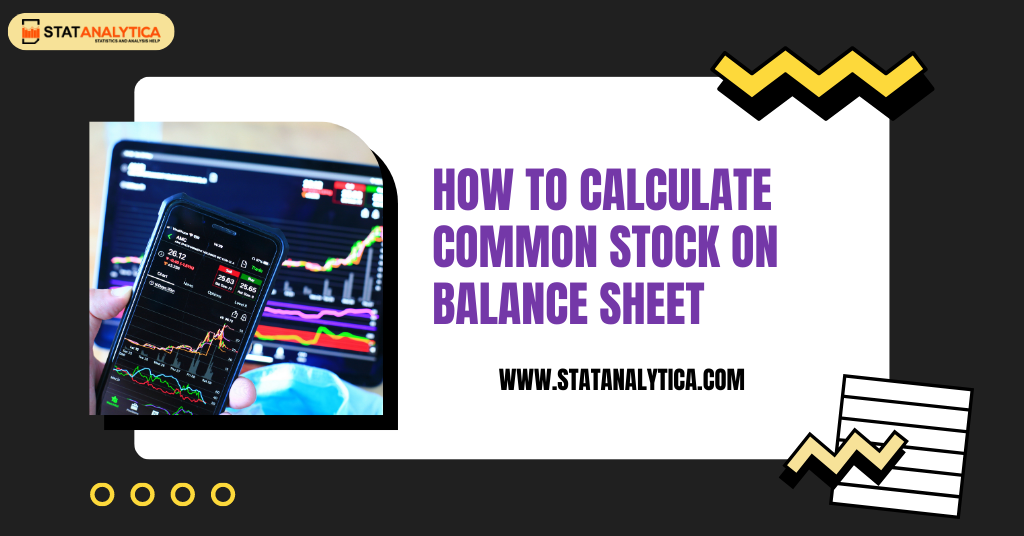Welcome, curious minds, to a journey into the intricate world of financial statements, where numbers hold the key to unlocking hidden treasures. Today, we embark on a captivating exploration of one crucial element on a company’s balance sheet: common stock. Prepare to be captivated as we unravel the secrets behind calculating this vital component, empowering you with the knowledge to decipher a company’s financial landscape like a seasoned analyst.
In the realm of finance, common stock represents more than just shares; it encapsulates ownership, influence, and potential. It is the lifeblood of a company’s equity, offering insight into the value and health of an organization. But how do we navigate the labyrinthine complexities of common stock calculation? Fear not, for we are about to demystify this process, unveiling the hidden wealth buried within financial statements.
Throughout this captivating journey, we will unravel the steps involved in calculating common stock, uncovering the significance of stock issuances, par value, and additional paid-in capital. Together, we will dive into the intricate tapestry of corporate finance, empowering you to see beyond the numbers and grasp the true essence of a company’s financial foundation.
So, prepare to delve into the world of balance sheets and unravel the secrets they hold. Join us on this exhilarating quest as we unearth the hidden wealth within and equip ourselves with the tools to decode the financial language spoken by corporations worldwide. Let’s embark on this thrilling adventure together and unravel how to calculate common stock on balance sheet.
What is the balance sheet?
Table of Contents
A balance sheet is a financial statement that provides a snapshot of a company’s financial position at a given point in time. It shows what a company owns (assets), what it owes (liabilities), and what is left over for shareholders (equity).
Assets are resources that a company owns or controls that have the potential to generate future economic benefits. Examples of assets include cash, accounts receivable, inventory, property, plant, and equipment.
Liabilities are obligations that a company owes to creditors or other parties. Examples of liabilities include accounts payable, loans, and other debts.
Equity represents the residual interest in the company’s assets after liabilities are deducted. It includes common stock, retained earnings, and other equity accounts.
The balance sheet follows the accounting equation: Assets = Liabilities + Equity. This equation means that the total value of a company’s assets must equal the sum of its liabilities and equity.
The balance sheet is an essential financial statement that provides insight into a company’s financial health and helps investors and analysts to make informed decisions.
Benefits of calculating common stock on balance sheet
Before knowing how to calculate common stock on balance sheet; let us know its advantages. Calculating common stock on the balance sheet has several benefits for companies, investors, and other stakeholders.
1. Provides Transparency
Calculating common stock on the balance sheet provides transparency into a company’s ownership structure. It shows how many shares are outstanding and how much money the company has received from issuing those shares.
Helps with Investment Decisions: Investors use the information provided by the balance sheet, including the common stock calculations, to make informed investment decisions. By understanding the number of shares outstanding and the total amount of capital that the company has received from issuing those shares, investors can evaluate the company’s financial health and potential for growth.
2. Determines Voting Rights
Common stockholders have voting rights that allow them to participate in important decisions that affect the company’s future. By calculating the number of shares outstanding, the company can determine how many votes each shareholder is entitled to.
3. Influences Dividend Decisions
Dividends are payments made by a company to its shareholders as a reward for investing in the company. By understanding the total amount of capital that the company has received from issuing shares of common stock, the company can determine whether it has enough funds to pay dividends to shareholders.
4. Helps with Valuation
The common stock calculation on the balance sheet is used to determine the book value of the company’s common stock. This information is used by investors to help determine the fair market value of the company and its common stock.
Why Is There A Need To Calculate Common Stock On The Balance Sheet ?
There are several reasons why it is important to calculate common stock on the balance sheet.
1. Financial Transparency
One of the primary reasons for calculating common stock on the balance sheet is to provide financial transparency. The balance sheet shows the company’s assets, liabilities, and equity, which helps stakeholders understand the company’s financial position. The calculation of common stock provides additional information about the company’s ownership structure and how many shares of stock are outstanding.
2. Investment Decision Making
Another reason for calculating common stock on the balance sheet is to help investors make informed investment decisions. Investors use the balance sheet to evaluate a company’s financial health and potential for growth. The calculation of common stock provides additional information about the company’s capital structure and how much money has been invested by shareholders.
3. Valuation of the Company
The calculation of common stock on the balance sheet is also important for valuing the company. Investors use the information provided by the balance sheet, including the calculation of common stock, to determine the fair market value of the company and its common stock.
4. Determination of Dividends
The calculation of common stock is important for determining the amount of dividends that a company can pay to its shareholders. The number of shares outstanding and the amount of capital invested in the company by shareholders are important factors in determining the amount of dividends that a company can afford to pay.
5. Voting Rights
The calculation of common stock is also important for determining the voting rights of shareholders. Each share of common stock represents one vote in corporate elections, such as the election of directors. The number of shares outstanding and the total amount of common stock provide important information about the voting rights of shareholders.
Calculating common stock on the balance sheet is important for providing financial transparency, helping investors make informed investment decisions, valuing the company, determining dividends, and determining voting rights.
Read More
Steps Involved in Calculating Common Stock on Balance Sheet
To know how to calculate common stock on balance sheet; let us understand the following steps:
1. Understanding Common Stock
Before diving into calculating common stock on the balance sheet, it is essential to understand what it is. Common stock represents ownership in a company, and shareholders who own common stock have voting rights and may receive dividends. The number of shares of common stock outstanding is listed on the company’s balance sheet, and the value of each share is determined by dividing the total value of the common stock by the number of shares outstanding.
2. Finding the Total Par Value of Common Stock
The first step in calculating common stock on the balance sheet is to determine the total par value of the common stock. Par value is the nominal value assigned to each share of stock. It is usually a small amount, such as $0.01 or $0.10 per share. To find the total par value of common stock, multiply the number of outstanding shares by the par value per share. For example, if a company has 100,000 outstanding shares of common stock with a par value of $0.01 per share, the total par value of the common stock would be $1,000.
3. Finding the Additional Paid-in Capital
The next step is to determine the additional paid-in capital. Additional paid-in capital is the amount of money that shareholders have paid for shares of common stock that is above the par value. It represents the amount of capital the company has received from investors in excess of the nominal value of the shares.
To calculate the additional paid-in capital, subtract the total par value of the common stock from the total amount of cash that the company has received from issuing the shares. For example, if a company has received $120,000 from issuing 100,000 shares of common stock with a par value of $0.01 per share, the additional paid-in capital would be $119,000.
4. Adding Total Par Value and Additional Paid-in Capital
The next step is to add the total par value of common stock and the additional paid-in capital. This gives the total amount of capital that the company has received from issuing shares of common stock. For example, if a company has a total par value of $1,000 and additional paid-in capital of $119,000, the total amount of capital received from issuing shares of common stock would be $120,000.
5. Calculating the Book Value of Common Stock
The final step is to calculate the book value of common stock. The book value of common stock represents the total amount of equity that shareholders have in the company. To calculate the book value of common stock, subtract any dividends paid to shareholders from the total amount of capital received from issuing shares of common stock. For example, if a company has received $120,000 from issuing shares of common stock and has paid $10,000 in dividends, the book value of common stock would be $110,000.
How To Use Common Stock Calculations To Make Investment Decisions
Here are some things that will help in making investment decisions:
1. Understand Price-to-Earnings (P/E) Ratio
The P/E ratio helps you know if a stock is expensive or cheap. If it is high, it might be pricey; if it is low, it could be a good deal. But remember to compare it with other similar stocks.
2. Check Dividend Yield
Dividend yield tells you how much money a company gives to its shareholders. A higher yield is good for people who want regular income. But really high yields might mean the company is having problems.
3. Look at Earnings Per Share (EPS)
EPS shows how much profit a company makes for each share you own. More profit is better. Make sure the company’s EPS is steady or growing over time.
4. Consider Price-to-Book (P/B) Ratio
P/B ratio compares a stock’s price to its actual value. Lower P/B can mean a better deal, but it depends on the industry. Compare it to similar companies.
5. Research the Company
Before buying stock, look at the company’s financial health. Check its reports for debt, growth, and profits. Strong finances mean it’s a good long-term investment.
Tips for Analyzing Common Stock as an Investor
Here are some tips for analyzing common stock as an investor:
- Assess the company’s financial health by analyzing key financial statements like income, balance, and cash flow statements.
- Investigate the company’s competitive position within its industry, considering factors like market share, competitive advantages, and barriers to entry.
- Evaluate the management team’s track record and ability to execute the company’s business strategy effectively.
- Examine the company’s dividend history and potential for future dividend growth if income generation is a priority for your investment.
- Monitor macroeconomic and industry-specific trends that could impact the company’s performance and stock price.
Conclusion
In conclusion, this blog has discussed how to calculate common stock on balance sheet. Calculating common stock on a balance sheet is a fundamental task that provides insight into a company’s ownership structure and financial health. By understanding this process, investors, analysts, and stakeholders can make informed decisions and assess the company’s overall value.
Throughout this discussion, we have explored the steps involved in determining common stock, including analyzing stock issuances, understanding par value, and considering additional paid-in capital. We have seen how common stock represents the ownership stake held by shareholders and serves as a vital component of a company’s equity.
By mastering this calculation, individuals gain a deeper understanding of a company’s capital structure, its ability to raise funds, and the potential dilution of ownership interests. Armed with this knowledge, stakeholders are better equipped to evaluate investments and gauge the financial strength of a company.
In conclusion, the ability to accurately calculate common stock on a balance sheet empowers individuals to make informed decisions and navigate the complex world of corporate finance with confidence.


